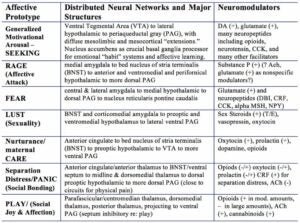
The above chart shows the work of Jaak Panksepp. His study in animals led him to a new theory of personality. Working with the idea of primitive base emotions he developed his theory of Affective Neuroscience. It is easy to see how his theories dovetail with what we need from detection dogs.
His studies discovered the primal behaviors that exist in our neuro-physiology in the forms of both brain anatomy and in the neuro-biology that drive the cognitive process. In fact he has proven these things are the base of our behaviors through extensive study. We know both brain structure and neuromodulators are heavily impacted through learning and development.
The combination of the SEEKING SYSTEM, the FEAR SYSTEM, the CARE SYSTEM, the PANIC SYSTEM, and the PLAY SYSTEM all lead to the development of a good detection dog. In panic and in fear systems we are looking for the opposite affects from those of the labels.
It’s the SEEKING SYSTEM that impresses me the most. It drives most of our behavior. It motivates us to behave even in the absence of an obvious or immediate reward. It is superior at anticipating reward at levels where the physiologic response associated with reward is higher in anticipation than it is at reward delivery.
In a properly developed dog this means the idea of the reward object and behavior of seeking the object drive the dog to perform. We want this system highly developed as the foundational behavior of doing detection work. They should show extreme motivation to find the object, should continue to possess the object when the handler plays tug, they should maintain possession independent of the handler/trainer, and should be able to track the object as it is being moved away from them.

